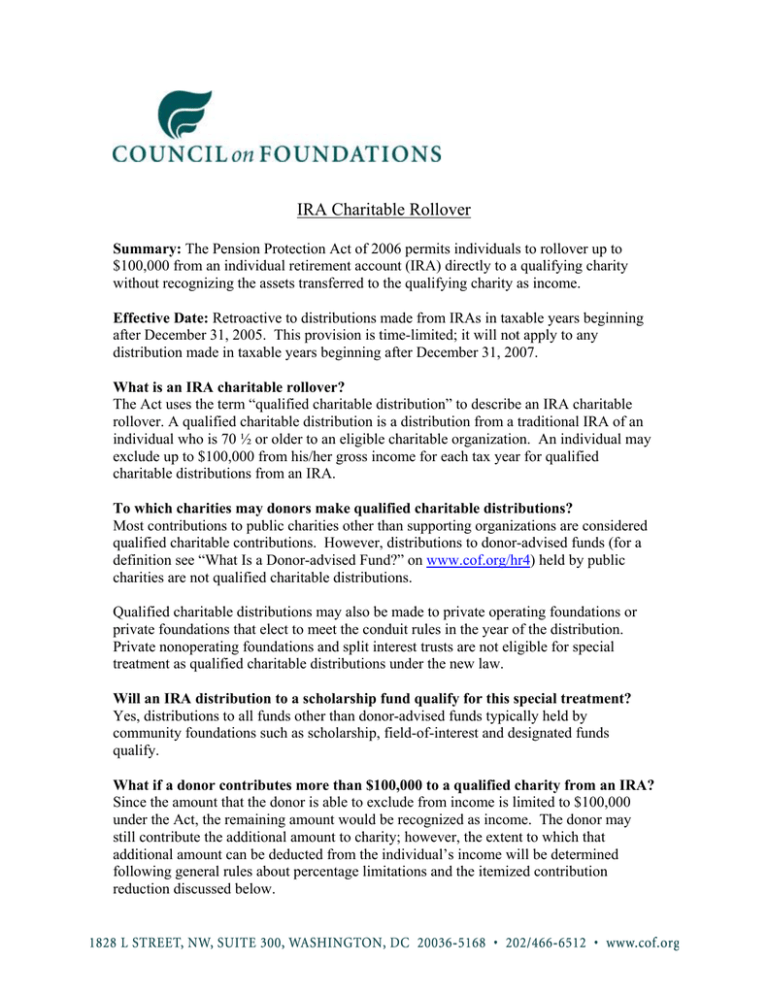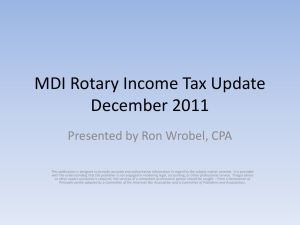IRA Charitable Rollover
advertisement

IRA Charitable Rollover Summary: The Pension Protection Act of 2006 permits individuals to rollover up to $100,000 from an individual retirement account (IRA) directly to a qualifying charity without recognizing the assets transferred to the qualifying charity as income. Effective Date: Retroactive to distributions made from IRAs in taxable years beginning after December 31, 2005. This provision is time-limited; it will not apply to any distribution made in taxable years beginning after December 31, 2007. What is an IRA charitable rollover? The Act uses the term “qualified charitable distribution” to describe an IRA charitable rollover. A qualified charitable distribution is a distribution from a traditional IRA of an individual who is 70 ½ or older to an eligible charitable organization. An individual may exclude up to $100,000 from his/her gross income for each tax year for qualified charitable distributions from an IRA. To which charities may donors make qualified charitable distributions? Most contributions to public charities other than supporting organizations are considered qualified charitable contributions. However, distributions to donor-advised funds (for a definition see “What Is a Donor-advised Fund?” on www.cof.org/hr4) held by public charities are not qualified charitable distributions. Qualified charitable distributions may also be made to private operating foundations or private foundations that elect to meet the conduit rules in the year of the distribution. Private nonoperating foundations and split interest trusts are not eligible for special treatment as qualified charitable distributions under the new law. Will an IRA distribution to a scholarship fund qualify for this special treatment? Yes, distributions to all funds other than donor-advised funds typically held by community foundations such as scholarship, field-of-interest and designated funds qualify. What if a donor contributes more than $100,000 to a qualified charity from an IRA? Since the amount that the donor is able to exclude from income is limited to $100,000 under the Act, the remaining amount would be recognized as income. The donor may still contribute the additional amount to charity; however, the extent to which that additional amount can be deducted from the individual’s income will be determined following general rules about percentage limitations and the itemized contribution reduction discussed below. 2 Can a donor contribute IRA assets to a donor-advised fund? Yes. However, since such distributions do not count as qualified distributions under these special rules, the donor will have to first recognize those distributions as income. The donor’s charitable deduction must then be calculated taking into account general principles relating to percentage limitations and the itemized contribution reduction discussed below. Under what circumstances will this special treatment of IRA charitable rollover most likely benefit a donor? Generally, donors who itemize deductions and whose charitable contributions will be reduced by the percentage of income limitation or by the itemized deduction reduction stand to benefit from these special rules. In addition, donors who do not itemize their deductions may also benefit. Finally, donors in some states may recognize greater benefits of a charitable rollover due to state income tax law. Donors will need to work with their professional advisors to determine the effect of these new rules on their specific tax situation. What are the percentage limitations? In any year, donors may not deduct more than 50 percent of their income for gifts of cash to public charities (30 percent, if giving to private foundations). Although amounts over 50 percent can be carried forward and deducted in future years, taxpayers will face an immediate tax bill and may lose some of the benefit of the deduction if they die before the gift has been fully deducted. Donors who consistently give above the limit will not be able to take advantage of the carry forward provisions. What is the itemized deduction reduction? Higher income taxpayers face limits on their itemized deductions. This reduction of itemized deductions is often referred to as the 3 percent floor. Before 2006, these taxpayers could lose up to 80 percent of the value of their deductions because most itemized deductions must be reduced by 3 percent of the amount by which the taxpayer’s adjusted gross income exceeds a certain amount which is adjusted annually for inflation (currently $150,500 or $75,250 for married people filing separately). For the years 2006 and 2007 the reduction on itemized deductions for affected taxpayers is reduced by onethird. Example: In the 2006 tax year, a married couple filing jointly has $1,000,000 in adjusted gross income (AGI). Because the couple’s AGI exceeded $150,500, the phase-out rules will apply to the couple’s itemized deductions. Itemized deductions for the couple were $150,000.* 1. AGI $ 1,000,000 2. Excess of couple’s AGI over $150,500 threshold $ 849,500 3. Calculate 3% of excess (3% of $849,500) Calculate 80% of itemized deductions (80% of $150,000) $ 25,485 $ 120,000 3 4. Determine lesser of the two calculations from Step 3 $ 25,485 5. Multiple the lesser of the two calculations by 2/3 $ 16,990 (This step accounts for the reduction for 2006 and 2007.) The couple’s itemized deductions will be reduced by $16,990 resulting in the couple being able to claim $133,010 in itemized deductions. Presuming the couple’s tax rate is 35 percent, the reduction in itemized deductions potentially results in additional taxes of approximately $5,945. * Note that this is a simplified example that does not take into account itemized deductions such as deductions for medial expenses which are not affected by the reduction. Is an individual required to pay state income tax on a qualified charitable distribution? In many states, a qualified charitable distribution will also be excluded from income for the purposes of calculating an individual’s state income tax obligations. However, some states may include such a distribution when calculating taxable income. For specific information on the treatment of a distribution in your state, check with local counsel or the relevant state revenue department. How does an individual make a qualified charitable distribution? An individual will direct his or her IRA trustee to make the contribution directly. Should a charity receiving a contribution directly from an IRA provide a gift acknowledgement? Yes. An individual must obtain a contemporaneous written acknowledgement of the contribution to take advantage of the treatment of the contribution under this new provision. IRS Publication 1771, Charitable Contributions—Substantiation and Disclosure Requirements (http://www.irs.gov/pub/irs-pdf/p1771.pdf) contains information about substantiation of charitable contributions. May a charity provide any goods or services in return for the contribution? No. If a donor receives any goods or services (e.g,. tickets to a fundraiser) that would have reduced the donor’s charitable deduction if the donor had made an outright gift to the charity, the rollover of assets from an IRA will not qualify for the tax-free treatment under this provision. Gifts to the donor that are disregarded (i.e., public recognition, token gifts and insubstantial benefits) will not disqualify the contribution from the taxfree treatment. IRS Publication 1771, Charitable Contributions—Substantiation and Disclosure Requirements (http://www.irs.gov/pub/irs-pdf/p1771.pdf) contains information about disregarded benefits. 4 Can an individual make a qualified charitable distribution for split interest gifts? No. Charitable lead trusts and charitable remainder trusts are examples of giving vehicles that are not eligible to receive qualified charitable distributions. Further, because an individual may not receive a benefit in return for an IRA distribution, a contribution in return for a charitable gift annuity would not eligible for the tax-free treatment. Do donors also receive a charitable deduction when they rollover assets to a charity under this provision? No. The benefit under this provision is that the individual does not recognize the amount contributed directly from the IRA to a qualifying charity. Because a donor does not include the amount in his or her gross income, the individual may not take a charitable contribution deduction for the contribution. To do so would allow a donor to receive a double benefit from the contribution so a charitable contribution deduction is explicitly prohibited. How will charitable distributions affect the minimum required distributions from a taxpayer’s IRA? Shortly after an individual reaches the age 70 ½, he or she is generally required to receive distributions from his or her traditional IRA. Distributions from an IRA to a charity will receive the same treatment as a distribution to the individual taxpayer for the purposes of minimum required distributions. Is a qualified charitable distribution technically an IRA rollover? No. While this charitable distribution is popularly known as an IRA charitable rollover, it is not technically a rollover. Generally, an IRA rollover allows an individual to withdrawal money from an IRA and transfer the money to another IRA within 60 days of the withdrawal. However, as noted above, a qualified charitable distribution must be transferred directly from the IRA administrator to the charity. What are the private foundation conduit rules? A private foundation may elect to meet the conduit rules and pay out 100 percent of the contributions the foundation received in its tax year by the 15th day of the third month after the close of that tax year in addition to meeting its regular 5 percent distribution requirements. A private foundation may elect to be or not to be a conduit private foundation from year to year. While a private nonoperating foundation generally cannot receive a qualified charitable contribution from an IRA, a private non-operating foundation that elects to meet the conduit rules may receive such contributions. The information provided here is based on our continuing analysis of the bill. Every effort has been made to ensure accuracy of these documents. However, due to the complexity of the bill and the fact that many of these provisions introduce issues that are new to the Internal Revenue Code, please understand that this information is subject to change. The information is not a substitute for expert legal, tax or other professional advice and we strongly encourage grantmakers and donors to work with their counsel to determine the impact of this legislation on their particular situations. This information may not be relied upon for the purposes of avoiding any penalties that may be imposed under the Internal Revenue Code.




